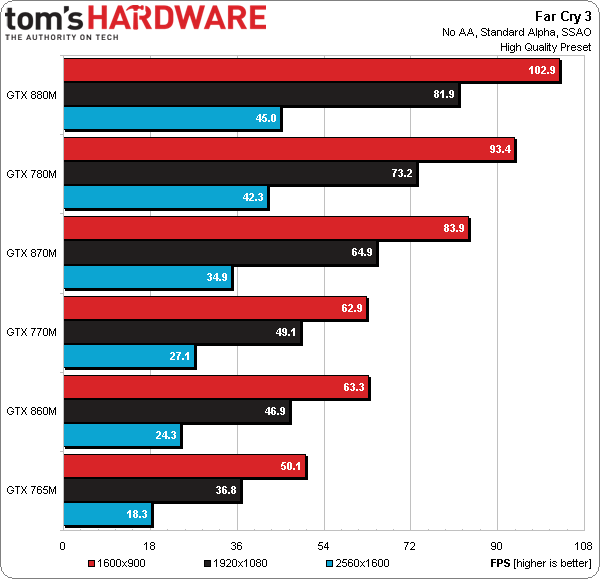GeForce GTX 880M, 870M, And 860M: Mobile GPUs, Tested
Nvidia is in the process of rolling out its GeForce GTX 800M-series graphics modules. Despite the new name, we're still looking at GK104-based GPUs. One thing is for sure, though: the processor is running faster than ever. We benchmark three models.
Results: Far Cry 3
Performance improvements inherent to the GeForce GTX 870M continue to impress us in Far Cry 3, where that particular flavor of GK104 starts looking like the minimum performance standard for QHD-equipped machines. Most mobile gamers are going to cap out at 1920x1080 though, and even the old GeForce GTX 765M is fast enough for FHD using the High detail preset.
Gamers who prefer Ultra quality on the same 1920x1080 screens will want to step up to Nvidia's GeForce GTX 870M. Even more powerful, the 880M and 780M still aren’t fast enough to push QHD resolutions at this quality level.
Get Tom's Hardware's best news and in-depth reviews, straight to your inbox.
Current page: Results: Far Cry 3
Prev Page Results: Battlefield 4 Next Page Results: Metro: Last Light-
CaptainTom Eh these generations are all the same cards. Show us a 980M with full maxwell. Then we'll talk...Reply -
Puiucs we need them to finish working on 20nm fast. TSMC just can't do it anymore. global foundries has 14nm only on paper too....Reply -
guvnaguy I'm actually fairly impressed. Their website says a max of 6 hours battery on "UMA" mode. Would you be able to test this, Tom?Reply
Previously I wouldn't consider getting a gaming laptop due to their short battery life, even when not gaming. But if a laptop with this kind of hardware can manage 5 - 6 hours, I'd consider it... -
ubercake Page one gives the impression you might include desktop cards so we could get a frame of reference with regard to desktop v laptop GPU performance. Then I looked immediately at the BF4 page and found no desktop GPUs in the performance charts?Reply -
Ninjawithagun Highly disappointed overall by the 800M series performance. I can feel assured that my GTX780Ms in my Alienware 18 will serve me well for at least another year. So, whatever happened to multi-core GPUs?? The concept works well for desktop CPUs, yet we have not seen it in desktop or mobile GPUs as of yet? ATI's Hawaii GPU comes close in certain aspects regarding behavior like a multi-core GPU by handing off processes to other chips within the die. One step closer to a next-gen GPU, yet still so far...Reply -
jrharbort A shame this didn't include the Maxwell-based 860M. It performs much more in line with what we'd expect from a true next-gen mobile chip (I'm currently using said chip, and still exercising its capabilities). I can say it's roughly 30% faster than the previous gen 765M, and benchmarks by others have shown it to be twice as fast as the GTX 660M while staying at a max of 50W TDP. I've yet to do any real benchmarking myself, so if anyone cares to see any, leave me some suggestions of what to use (preferably free software).Reply -
hannibal Is there any way of knowing if you get kepler 860 or maxwell 860 when you buy a laptop?Reply
I hate these kind of naming tricks... Even 860a and 860b or anything that gives out what you will get.
-
jrharbort ReplyIs there any way of knowing if you get kepler 860 or maxwell 860 when you buy a laptop?
It is difficult to know unless you get more specific information from the manufacturer before purchase (or find benchmarks of the computer model you're looking at beforehand). The MSi GE60 Apache Pro was the first notebook to feature the Maxwell-based 860M.
I hate these kind of naming tricks... Even 860a and 860b or anything that gives out what you will get. -
dstarr3 ReplySo, whatever happened to multi-core GPUs?? The concept works well for desktop CPUs, yet we have not seen it in desktop or mobile GPUs as of yet?
GPUs have been multi-core for ages now. Well beyond desktop cores, even. The GTX880M in particular is a 1,536-core GPU. Similar numbers have been around for a long time.
http://www.geforce.com/hardware/notebook-gpus/geforce-gtx-880m/specifications




